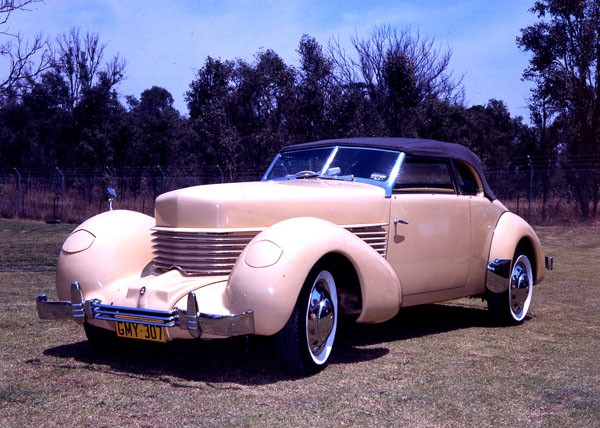After taking over Auburn and Duesenberg in 1929 Erret Lobban Cord launched a luxury car honoured with his name. As might be expected, the L-29 Cord was handsome and notable for its front-wheel drive; one of the first commercial applications of fwd. Around 4400 L-29s were produced over a two year period but the car was then discontinued as it was plagued with mechanical problems such as badly chosen gear ratios, low geared steering, traction problems climbing steep hills and comparative costliness during the Depression years.
Two years later with sales of Auburns and Duesenbergs declining, Cord engaged Gordon Buehrig, who had a background with Stutz and General Motors, to design a luxury sporting car. This would feature front-wheel drive but instead of the long engine would be coupled to a reversed V8 engine of 4730 cc and developing 93 kW produced by Lycoming, another of Cord’s companies.
This car had an interesting body design with a rear-hinged grille-less bonnet design with horizontal fin like louvres at the bonnet front which continued along both sides, retracting headlamps adapted from aircraft landing lights, flush tail lights and a flush cover over the fuel filler cap. The convertibles had wind-up windows all round and a top capable of disappearing into a metal covered well. Unlike many highly styled cars, Buehrig’s Cord provided ample space for its passengers. Except for its restricted glass area, the body remains a masterpiece of inspired originality.
After some initial delays production finally got under way in the first quarter of 1936. In addition to the V8 engine the Cord 810 also had a four-speed transmission which included an overdrive ratio at a time when other American cars all had three-speed transmissions. In the following year the 812 was introduced. This car was similar to the 810 but had a supercharged engine which developed 145 kW.
The 1936-37 Cords were notable for performance as well as aesthetics. In standard 93 kW form they had a top speed just short of 145km/h, although the slow-responding pre-selector transmission made for sluggish acceleration. With the supercharger the 812 had a top speed in excess of 160 km/h. This, coupled with roadholding and cornering qualities unequalled in America, made both models popular.
Today all 1936-37 body types are highly prized, whether they be four-door saloons, two-door or four-door convertibles, or the long wheelbase 1937 Berline with chauffeur division, oddly featured in a car promoted as ideal for the owner-driver!









